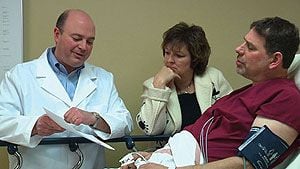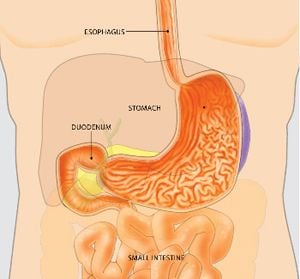This information was developed by the Publications Committee of the American Society for Gastrointestinal Endoscopy (ASGE). For more information about ASGE, visit www.asge.org. This information is intended only to provide general guidance. It does not provide definitive medical advice. It is important
Read moreAbdominal pain
- Patient information: Abdominal pain (functional dyspepsia) in adults
- Patient information: Chronic abdominal pain in children and adolescents
Achalasia
Anal fissure
Barrett’s esophagus
Blood in the stool
- Patient information: Blood in the stool (rectal bleeding) in adults
- Patient information: Bloody stools in children
Celiac disease
Colorectal cancer
Constipation
- Patient information: Constipation in adults
- Patient information: Constipation in infants and children
Crohn’s disease
- Patient information: Crohn’s disease
- Patient information: Inflammatory bowel disease and pregnancy
- Patient information: Sulfasalazine and the 5-aminosalicylates
- Patient information: Surgical treatment of Crohn’s disease
Diarrhea
- Patient information: Acute diarrhea in adults
- Patient information: Acute diarrhea in children
- Patient information: Antibiotic-associated diarrhea (Clostridium difficile)
- Patient information: Chronic diarrhea in adults
Diet
Diverticulosis and diverticulitis
Endoscopy
- Patient information: Colonoscopy
- Patient information: ERCP (endoscopic retrograde cholangiopancreatography)
- Patient information: Flexible sigmoidoscopy
- Patient information: Upper endoscopy
Eosinophilic esophagitis
ERCP
Fecal incontinence
Food allergies
Gallstones
Gas and bloating
Gastroesophageal reflux disease (GERD)
- Patient information: A guide to gastroesophageal reflux disease (GERD, acid reflux, heartburn)
- Patient information: Gastroesophageal reflux disease in adults
- Patient information: Gastroesophageal reflux disease in children and adolescents
- Patient information: Gastroesophageal reflux in infants
Helicobacter pylori
Hemorrhoids
HEPATITIS
- Patient Information Hepatitis A
- Patient Information Hepatitis B
- Patient Information Hepatitis C
- Patient Information: Autoimmune Hepatitis
Irritable bowel syndrome
Liver biopsy
Liver disease
- Patient information: alpha-1 antitrypsin deficiency
- Patient information: Autoimmune hepatitis
- Patient information: Cirrhosis
- Patient information Hemochromatosis (hereditary iron overload)
- Patient information: Nonalcoholic steatohepatitis (NASH)
Nausea and vomiting
- Patient information: Nausea and vomiting in infants and children
- Patient information: Nausea and vomiting of pregnancy
Pancreatitis
Peptic ulcers
- Patient information: Helicobacter pylori infection and treatment
- Patient information: Peptic ulcer disease
Polyps
Sigmoidoscopy
Ulcerative colitis
- Patient information: Inflammatory bowel disease and pregnancy
- Patient information: Sulfasalazine and the 5-aminosalicylates
- Patient information: Ulcerative colitis
Wilson’s Disease
This information was developed by the Publications Committee of the American Society for Gastrointestinal Endoscopy (ASGE). For more information about ASGE, visit www.asge.org.
This information is intended only to provide general guidance. It does not provide definitive medical advice. It is important that you consult your doctor about your specific condition.
Download this article in PDF format
Don't have Adobe Reader? Download it here
 Flexible sigmoidoscopy enables the doctor to carefully examine the rectum and sigmoid colon, and to take tissue from the lining of the colon for a biopsy.
Flexible sigmoidoscopy enables the doctor to carefully examine the rectum and sigmoid colon, and to take tissue from the lining of the colon for a biopsy.What is flexible sigmoidoscopy?
Flexible sigmoidoscopy lets your doctor examine the lining of the rectum and a portion of the colon (large intestine) by inserting a flexible tube about the thickness of your finger into the anus and slowly advancing it into the rectum and lower part of the colon.
What preparation is required?
Your doctor will tell you what cleansing routine to use. In general, preparation consists of one or two enemas prior to the procedure but could include laxatives or dietary modifications as well. However, in some circumstances your doctor might advise you to forgo any special preparation. Because the rectum and lower colon must be completely empty for the procedure to be accurate, it is important to follow your doctor's instructions carefully.
 If polyps are found during the procedure, the doctor may take a tissue sample for biopsy. Some polyps are totally harmless. Others, though benign, may have a small risk of becoming cancerous.
If polyps are found during the procedure, the doctor may take a tissue sample for biopsy. Some polyps are totally harmless. Others, though benign, may have a small risk of becoming cancerous.Should I continue my current medications?
Most medications can be continued as usual. Inform your doctor about medications that you're taking, particularly aspirin products, anti-coagulants (blood thinners such as warfarin or heparin), or clopidogrel, as well as any allergies you have to medications.
What can I expect during flexible sigmoidoscopy?
Flexible sigmoidoscopy is usually well-tolerated. You might experience a feeling of pressure, bloating or cramping during the procedure. You will lie on your side while your doctor advances the sigmoidoscope through the rectum and lower part of the colon. As your doctor withdraws the instrument, your doctor will carefully examine the lining of the intestine.
 Flexible sigmoidoscopy is almost always done on an outpatient basis. The procedure typically takes less than 15 minutes.
Flexible sigmoidoscopy is almost always done on an outpatient basis. The procedure typically takes less than 15 minutes.What if the flexible sigmoidoscopy finds something abnormal?
If your doctor sees an area that needs further evaluation, he or she might take a biopsy (tissue sample) to be analyzed. Obtaining a biopsy does not cause pain or discomfort. Biopsies are used to identify many conditions, and your doctor might order one even if he or she doesn't suspect cancer. If your doctor finds polyps, he or she might take a biopsy of them as well. Polyps, which are growths from the lining of the colon, vary in size and types. Polyps known as "hyperplastic" might not require removal, but other benign polyps known as "adenomas" have a small risk of becoming cancerous. Your doctor will likely ask you to have a colonoscopy (a complete examination of the colon) to remove any large polyps or any small adenomas.
 Flexible sigmoidoscopy enables the doctor to carefully examine the rectum and sigmoid colon, and to take tissue from the lining of the colon for a biopsy.
Flexible sigmoidoscopy enables the doctor to carefully examine the rectum and sigmoid colon, and to take tissue from the lining of the colon for a biopsy.What happens after a flexible sigmoidoscopy?
Your doctor will explain the results to you when the procedure is done. You might feel bloating or some mild cramping because of the air that was passed into the colon during the examination. This will disappear quickly when you pass gas. You should be able to eat and resume your normal activities after leaving your doctor's office or the hospital, assuming you did not receive any sedative medication.
What are possible complications of flexible sigmoidoscopy?
Flexible sigmoidoscopy and biopsy are safe when performed by doctors who are specially trained and experienced in these endoscopic procedures. Complications are rare, but it's important for you to recognize early signs of possible complications. Contact your doctor if you notice severe abdominal pain, fevers and chills, or rectal bleeding. Note that rectal bleeding can occur several days after the exam.
Download this article in PDF format
Don't have Adobe Reader? Download it here
Important Reminder: This information is intended only to provide general guidance. It does not provide definitive medical advice. It is very important that you consult your doctor about your specific condition.
 Since its founding in 1941, the American Society for Gastrointestinal Endoscopy (ASGE) has been dedicated to advancing patient care and digestive health by promoting excellence in gastrointestinal endoscopy. ASGE, with more than 11,000 members worldwide, promotes the highest standards for endoscopic training and practice, fosters endoscopic research, and is the foremost resource for endoscopic education.
Since its founding in 1941, the American Society for Gastrointestinal Endoscopy (ASGE) has been dedicated to advancing patient care and digestive health by promoting excellence in gastrointestinal endoscopy. ASGE, with more than 11,000 members worldwide, promotes the highest standards for endoscopic training and practice, fosters endoscopic research, and is the foremost resource for endoscopic education.
This patient education brochure was developed by the Publications Committee of the American Society for Gastrointestinal Endoscopy. This information is the opinion of and provided by the American Society for Gastrointestinal Endoscopy.
American Society for Gastrointestinal Endoscopy www.asge.org and www.screen4coloncancer.org
-
Understanding Flexible Sigmoidoscopy
Category: Understanding Flexible Sigmoidoscopy
Contact Us
Send us an Email Today!
Our Location
Find us on the map
Hours of Operation
Our Regular Schedule
San Diego Gastroenterology
Monday:
9:00 AM-4:00 pm
Tuesday:
9:00 AM-4:00 pm
Wednesday:
9:00 AM-4:00 pm
Thursday:
9:00 AM-4:00 pm
Friday:
9:00 AM-3:00 pm
Saturday:
Closed
Sunday:
Closed
Scripps Mercy Hospital
Monday:
6:30 am-3:00 pm
Tuesday:
6:30 am-3:00 pm
Wednesday:
6:30 am-3:00 pm
Thursday:
6:30 am-3:00 pm
Friday:
6:30 am-3:00 pm
Saturday:
Closed
Sunday:
Closed
San Diego Endoscopy Center
Monday:
7:00 am-4:30 pm
Tuesday:
7:00 am-4:30 pm
Wednesday:
7:00 am-4:30 pm
Thursday:
7:00 am-4:30 pm
Friday:
7:00 am-4:30 pm
Saturday:
Closed
Sunday:
Closed
